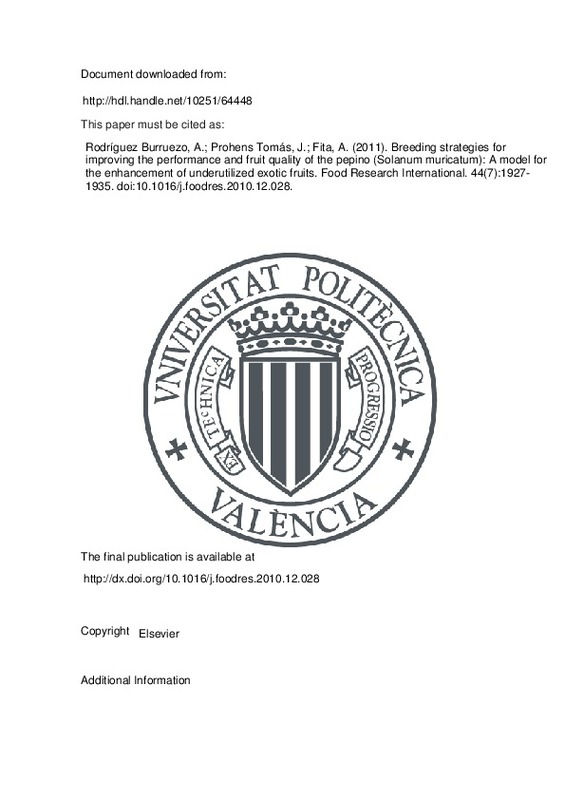JavaScript is disabled for your browser. Some features of this site may not work without it.
Buscar en RiuNet
Listar
Mi cuenta
Estadísticas
Ayuda RiuNet
Admin. UPV
Breeding strategies for improving the performance and fruit quality of the pepino (Solanum muricatum): A model for the enhancement of underutilized exotic fruits
Mostrar el registro sencillo del ítem
Ficheros en el ítem
| dc.contributor.author | Rodríguez Burruezo, Adrián
|
es_ES |
| dc.contributor.author | Prohens Tomás, Jaime
|
es_ES |
| dc.contributor.author | Fita, Ana
|
es_ES |
| dc.date.accessioned | 2016-05-20T06:22:26Z | |
| dc.date.available | 2016-05-20T06:22:26Z | |
| dc.date.issued | 2011-08 | |
| dc.identifier.issn | 0963-9969 | |
| dc.identifier.uri | http://hdl.handle.net/10251/64448 | |
| dc.description.abstract | The pepino (Solanum muricatum Aiton) is a neglected Andean crop that has elicited an increasing interest from exotic fruit markets. The pepino is highly diverse and, by using appropriate breeding strategies, it has been possible to develop new improved materials. Here we review more than a decade of efforts and advancements made in the genetic improvement of the pepino for several traits, with special emphasis on fruit quality. Different strategies, like the use of a wide diversity of genetic resources, exploitation of genotype × environment interaction, use of clonal hybrids, and introgression of genes from wild species, have facilitated significant developments in enhancing the commercial potential of the pepino, and have allowed the development of new cultivars and breeding materials adapted to new agroclimatic conditions. Agronomic performance of the pepino has been improved by the use of genetic parthenocarpy, selection for resistance to Tomato Mosaic Virus, and by developing hybrids, that manifested heterosis, but also did not have lower quality fruit. Breeding for quality has been focused mostly on the improvement of flavor (sweetness and aroma) and nutritional value (ascorbic acid content; AAC). Despite the limited intraspecific diversity available for sugar content, materials with high soluble solids content (SSC) have been selected. Strategies for further increases of SSC and titratable acidity have been based in the use of wild relatives. The study of variation within the cultigen was also helpful in the selection of hybrid genotypes with improved aroma profiles and high AAC values. As a result of the breeding efforts, several cultivars with improved agronomic performance and fruit quality have been produced. The use of biotechnological tools represents an opportunity to use the extensive genomic information compiled for related species, like tomato or potato, for the future improvement and enhancement of pepino quality. The results obtained in the pepino show that ample opportunities exist for improving the commercial potential of under-utilized fruits by means of breeding based on the exploitation of genetic diversity. © 2010 Elsevier Ltd. | es_ES |
| dc.language | Inglés | es_ES |
| dc.publisher | Elsevier | es_ES |
| dc.relation.ispartof | Food Research International | es_ES |
| dc.rights | Reserva de todos los derechos | es_ES |
| dc.subject | Chemical composition | es_ES |
| dc.subject | Exotic fruits | es_ES |
| dc.subject | Nutritional quality | es_ES |
| dc.subject | Organoleptic quality | es_ES |
| dc.subject | Plant breeding | es_ES |
| dc.subject | Solanum muricatum | es_ES |
| dc.subject | Chemical compositions | es_ES |
| dc.subject | Agronomy | es_ES |
| dc.subject | Genes | es_ES |
| dc.subject | Ketones | es_ES |
| dc.subject | Organic acids | es_ES |
| dc.subject | Plants (botany) | es_ES |
| dc.subject | Sugars | es_ES |
| dc.subject | Viruses | es_ES |
| dc.subject | Fruits | es_ES |
| dc.subject | Lycopersicon esculentum | es_ES |
| dc.subject | Solanum | es_ES |
| dc.subject | Solanum tuberosum | es_ES |
| dc.subject | Tomato mosaic virus | es_ES |
| dc.subject.classification | GENETICA | es_ES |
| dc.title | Breeding strategies for improving the performance and fruit quality of the pepino (Solanum muricatum): A model for the enhancement of underutilized exotic fruits | es_ES |
| dc.type | Artículo | es_ES |
| dc.identifier.doi | 10.1016/j.foodres.2010.12.028 | |
| dc.rights.accessRights | Abierto | es_ES |
| dc.contributor.affiliation | Universitat Politècnica de València. Departamento de Biotecnología - Departament de Biotecnologia | es_ES |
| dc.description.bibliographicCitation | Rodríguez Burruezo, A.; Prohens Tomás, J.; Fita, A. (2011). Breeding strategies for improving the performance and fruit quality of the pepino (Solanum muricatum): A model for the enhancement of underutilized exotic fruits. Food Research International. 44(7):1927-1935. doi:10.1016/j.foodres.2010.12.028 | es_ES |
| dc.description.accrualMethod | S | es_ES |
| dc.relation.publisherversion | http://dx.doi.org/10.1016/j.foodres.2010.12.028 | es_ES |
| dc.description.upvformatpinicio | 1927 | es_ES |
| dc.description.upvformatpfin | 1935 | es_ES |
| dc.type.version | info:eu-repo/semantics/publishedVersion | es_ES |
| dc.description.volume | 44 | es_ES |
| dc.description.issue | 7 | es_ES |
| dc.relation.senia | 193451 | es_ES |







![[Cerrado]](/themes/UPV/images/candado.png)

